Samsung Fascinate Review: Verizon's Galaxy S Smartphone
by Brian Klug on October 5, 2010 12:01 AM EST- Posted in
- Smartphones
- Samsung
- Galaxy S
- Fascinate
- Mobile
Super AMOLED
Anand talked about the Galaxy S line's Super AMOLED display in his Epic 4G review. I thought I'd expand on that by saying that reducing the number of layers and air gaps between display, coating, capacitive digitizer, and finally top layer glass, is what the "Super" in Super AMOLED is all about.
It might not sound like a big deal, but reducing the number of interfaces between those light emitting OLED pixels and your eye is hugely important. Each successive interface - purely by being an interface with different index of refraction - creates a reflection that attenuates light. Glass to air interfaces usually have a reflection coefficient of around 4%, meaning only 96% of light makes it through. If you've got two or more air-glass interfaces, that adds up quickly, and you lose that light entirely to reflection. How much that reflection coefficient is depends on the index of materials at the interface, but more interfaces in general hurts transmission. Reflections and glare is also what makes reading displays difficult outside.
This sort of display-digitizer lamination is quickly becoming the norm rather than the exception. The iPhone 4 did it, and now Samsung is doing it with its own AMOLED displays - expect to see others do the same. The result is that there's perceptibly less distance between the top of the digitizer and the pixels themselves (viewed from an angle), and now less glare and more light making it through. Yay for optical contact!
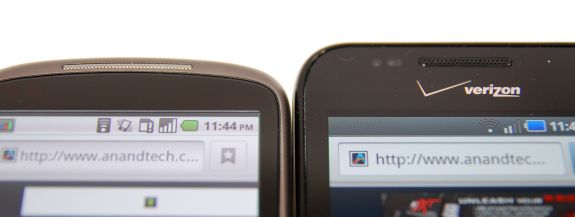
View this one bigger in full size to see what I mean
Next to the Nexus One, you can really see how much less distance there is between pixels and the surface of the top glass. The Samsung's Super AMOLED display literally appears to be on the surface.
The front of the Fascinate is one unbroken glass surface. Honestly, the display is probably the best part of the Fascinate. The 4" size isn't too big, but just right. At the bottom are capacitive buttons - as usual in yet a different order than I'm used to. Menu at the far left, home, back, then search from left to right.
The buttons are backlit, but only for a few seconds at a time. It's a bit frustrating, especially since right when you want them to be backlit most, they're inexplicably not lit.
I'd say AMOLED has come a long way since the Nexus One. My Nexus One routinely has ghosting and appears off-white - the Fascinate's Super AMOLED display is perfect. I used to be turned off by AMOLED's weird grain from the PenTile matrix - the Fascinate somehow has noticeably less. Either that, or I've just grown more accustomed to it. The oversaturation downside is still there, it's especially obvious when you pull screenshots from the Fascinate or any AMOLED device down to the desktop on a calibrated display.
Outside readability in practice is improved from the Nexus One. Honestly, it's still hard to read in direct sunlight outside, but it's better. For doing just about anything, seek shade.
Viewing angles on Super AMOLED are pretty awesome. I'd say contrast is pretty much unchanged even at extreme angles like 85 degrees. I've included lots of different angles and more outdoor and indoor comparison shots in the gallery below.
The oddest parts of the Fascinate's display are all the brightness settings. There are three of them - one in settings that every Android device has, another down below that's basically dynamic contrast, and one in the browser. It can get a bit confusing controlling everything that's going on brightness wise.
I measured a bit more brightness than Anand did on the Epic 4G:
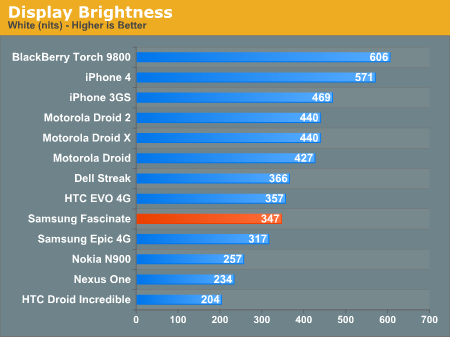
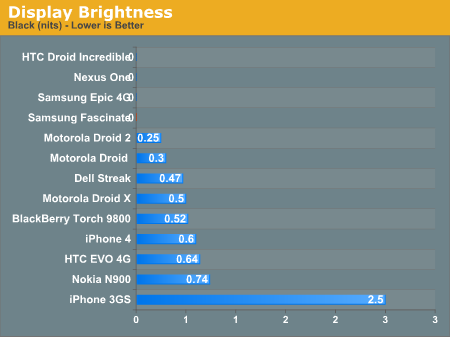
Black levels are perfect again, and thus so is contrast.
I have to agree with Anand - if resolution is what you care about, the iPhone 4 leads. If contrast and seriously vibrant (to the point of being oversaturated) colors are what you like, Super AMOLED is where it's at.


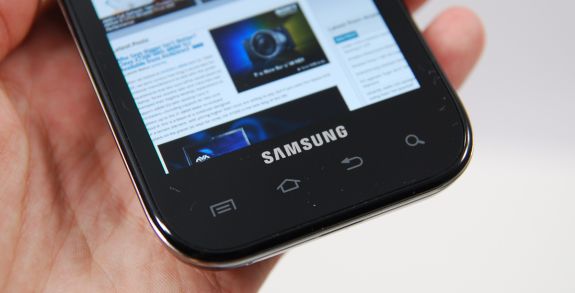
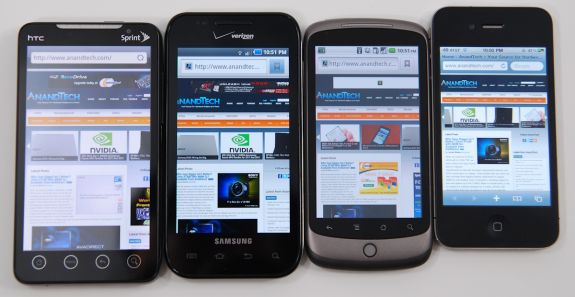
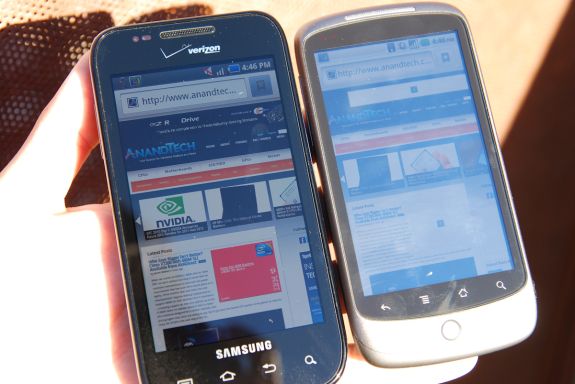














73 Comments
View All Comments
Ethaniel - Tuesday, October 5, 2010 - link
Good thing you directly recommend rooting and flashing the device. That Verizon-pseudo Google-Bing combo is kinda creepy... and bloated.medi01 - Tuesday, October 5, 2010 - link
"Outside readability in practice is improved from the Nexus One. "Dare I ask whether it is improved from, God forbid, iPhone 4? :rolleyes:
deputc26 - Tuesday, October 5, 2010 - link
In the performance page,Loading Engadget Times
EVO Should be 2.2 not 2.1.
Brian Klug - Tuesday, October 5, 2010 - link
I haven't included numbers from the EVO running 2.2 yet, although I've got them and will do so, those are current for 2.1 (as marked) ;)-Brian
Shlong - Tuesday, October 5, 2010 - link
it seems the Epic with Sprint is the best out of the Galaxy S line.alovell83 - Tuesday, October 5, 2010 - link
The Korean Galaxy S would beg to differ. FF cam + DMB. Yes, you do lose out on 4G, but you save hundreds on the life of the contract and it isn't as much up front either. Out of those available to the U.S. it's the $10 4G tax, without necessarily receiving a 4G signal which is the bummer, but you still get the best kit subsidized state-side. Living in a 4G city, the Epic is a no-brainer. Outside, we are talking about $300 more, assuming you don't get an amazon $.01 deal which would bump the contract life of the Epic to more than $400 more than the others...just for a FF camera and (cross you fingers, hopefully) to one day get a 4G signal in your city is just asking for too much.silverblue - Tuesday, October 5, 2010 - link
I have the UK version of the Galaxy S, and it's quite odd how many variants are out there. Differences on the UK version:1) no LED flash
2) sports an FF cam
3) the micro-SD slot is on the left inside the back, with the SIM card to the right and the built-in micro-SD above that
4) the buttons are confined to Menu on the left, Back on the right, and a physical Home key in the middle
5) the headphone socket has a black plastic surround instead of chrome effect (strangely, the review states 18mm - shouldn't that be 35mm?)
6) there's a "with Google™" logo on the back along with the SAMSUNG logo but no mention of Galaxy S; there's no mention of the carrier.
7) the phone weighs less at 118g
8) The default wallpaper isn't a Live one
deputc26 - Tuesday, October 5, 2010 - link
Interesting and yes that should be 35mmBrian Klug - Tuesday, October 5, 2010 - link
Yeah, I meant 3.5mm, 1/8 inches. Fixed ;)-Brian
chemist1 - Tuesday, October 5, 2010 - link
The single most important function of a phone is to, well, be a phone, i.e., do voice communication. And one of the characteristics most important to voice communication is the audio quality---both sending and receiving (via the earpiece or a headset; the percent of time spent listening via speakerphone is, for most, is less than for the earpiece or a headset). Yet, in a very long and otherwise thorough review, I could find only one sentence that addressed earpiece audio quality:"Earpiece performance and volume is adequate - voice quality is as good on the Fascinate as I've seen on other CDMA handsets in the testing I performed."
And I could find no mention of audio quality from the headset jack, nor any mention of audio quality for someone on the receiving end of a call from this phone.
It's sort of like reading a detailed review of a new camera, in which lots of attention is given to metering, focus, etc. (all parameters that affect image quality), but with only a single sentence on how good the images are after metering, focus, etc. is dialed in. Likewise, you have several paragraphs on issues that affect audio quality -- e.g., the dependence of signal attenuation on how the phone is held-- but again, only one sentence on how good the phone actually sounds (and nothing on how good I sound to someone I'm calling) after these secondary effects are taken care of. I.e., suppose I'm receiving a call under ideal conditions (say, it's from a land line, there's a strong signal, I am holding the phone optimally, etc.). In that case, do you mean to tell me that someone with a trained ear would hear no difference in audio quality when listening through the earpieces of different CDMA handsets? While this may be true, I certainly would not be convinced of that based on reading just your one sentence, since it does not give the impression that a serious attempt to assess audio quality has been made.
As you can likely tell, I'd like to strongly suggest that, in future reviews, the comparative audio quality of these phones is addressed in a more serious and discriminating manner, by someone with extensive audio expertise and a highly trained ear. The reason your site is so well-respected is because it brings an unusual level of sophistication to computer hardware reviews. I’d like to see that same sophistication applied to audio performance, when you are reviewing devices where audio performance should be central (phones and portable music players).
I've been following this site for many years, and I think you folks are the best --- you do a fantastic job. But your expertise is computers, it's not audio. And often, when you venture into audio, I don't see it approached it with the level of sophistication with which you approach computer hardware. You can see your site's extraordinary sophistication with computer hardware with, for instance, Anand's perspicacious reviews of SSDs, in which he identified 4K random read and write speeds (as opposed to sequential large-block performance) as being the key to real-world performance. Yet, by contrast, when Anand was reviewing the audio perfomance of the iPod Nano, he just cookbooked the standard set of Rightmark Audio Analyzer measurements (http://www.anandtech.com/show/3903/apples-ipod-tou... he didn't demonstrate the audio expertise to first listen, and then make an informed decision of which measurements needed to be done. If he had, he might have realized that problems lie in areas that would only be revealed by a different set of measurements. Anand then went on to say "I believe we've hit a ceiling for PMP audio playback quality." Well, no, it could still be improved quite a bit. It is informative to contrast how Anand approached audio with, for instance, Marc Heijligers' astute analysis of iPod audio performance, at: http://homepage.mac.com/marc.heijligers/audio/ipod...
[I did mention this in the comments for Anand’s review, but it was towards the end of the thread, so they may not have been noticed.]
I suspect that, if you want the audio component of your reviews to be up to the high level of sophistication you show for computer hardware, you're going to need to bring in someone with years of audio expertise and a highly trained ear.
Thanks for listening to this very long comment!